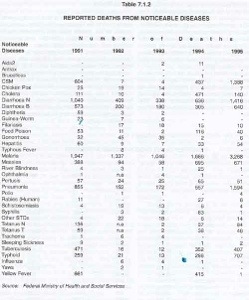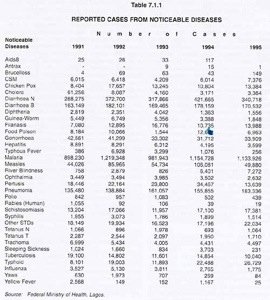Health conditions in Nigeria a statistical overview
From all indications, the health condition in Nigeria is highly deplorable. Among the most common diseases in Nigeria are malaria, guinea worm, pneumonia, measles, gonorrhoea, schistosomiasis, typhoid, tuberculosis, chicken pox, diarrhoea and, more recently, AIDS. Whereas reported cases from noticeable diseases were about 1.78 million in 1991, the figure rose to some 2.06 million by 1995 Table 7.1.1.
As shown in Table 7.1.2, reported deaths from diarrhoea N rose from 1,040 in 1991 to 1,416 in 1995 while those from diarrhoea B rose from 573 to 640 over the same period. Malaria, on the other hand, claimed about 1,947 lives in 1991, rising to 3,268 by 1995 and measles claimed 388 in 1991 rising to 671 in 1995. Also, during the same period, deaths due to pneumonia almost doubled, rising from 855 to 1,594, while deaths due to typhoid fever increased from 259 to 707.
The foregoing only demonstrate part of the deplorable condition of the health sector in Nigeria. Attempts to look at the accessibility level of Nigerians to medical practitioners further compound the situation. For a population of about 89 million in 1991, Nigeria had only 20,210 medical doctors which gives a ratio of one doctor to about 4,400 people. Similarly, with only about 106,453 hospital beds in 1991, bed space per head in Nigeria was at the ratio of one bed to 800 person.
At the States level, the situation is even far more gloomy. In Benue and Katsina States, for example, in 1997 the ratio was one medical doctor to about 27,000 and 41,000 people, respectively. In some of the States of the country the situation is even worse.
As a result, both crude death rate and infant mortality rates are still very high at seventeen deaths per 1,000 population and 119 deaths per 1,000 live-births, respectively. Moreover, live expectancy at birth is as low as forty-eight years for the males and fifty for the females.
The Federal and State Governments are the major providers of basic health facilities and services in Nigeria. They often reportedly provide sub stantial sums of money for various aspects of the health sector in the country. Those areas most affected are manpower development; purchase and distribution of druas and vehicles: construction of new specialist hospitals; national campaigns against AIDS and other sexually transmitted diseases; mass inoculation of adults and youths against dreadful diseases like cholera and tuberculosis; mass immunisation of children against the killer diseases; mass education on modern personal hygiene, environmental sanitation and appropriate solid waste disposal and management meth ods; and, family planning.
The deplorable condition of the health sector in the country, in spite of government spending on the sector, raises serious concerns about the manage ment of the health sector; the adequacy of funding for the sector; its focus and use; and, about the management generally.
At this point, it is appropriate to acknowledge the efforts and support of international organisa tions, like WHO, UNICEF, UNDP, and the Carter Foundation, whose contributions towards the con trol and eradication of deadly communicable and infectious diseases like guinea worm, tuberculosis, cholera, river blindness, and schistosomiasis in Nigeria have been very significant.




















